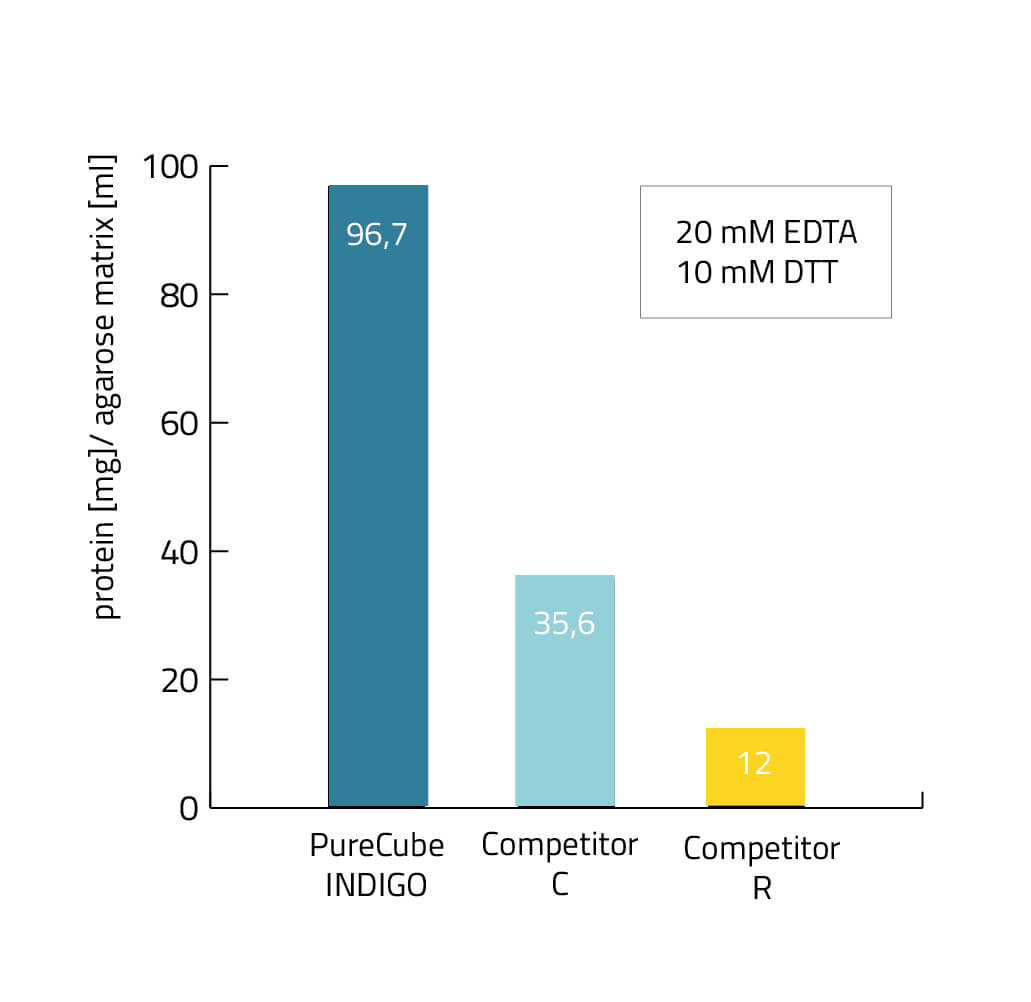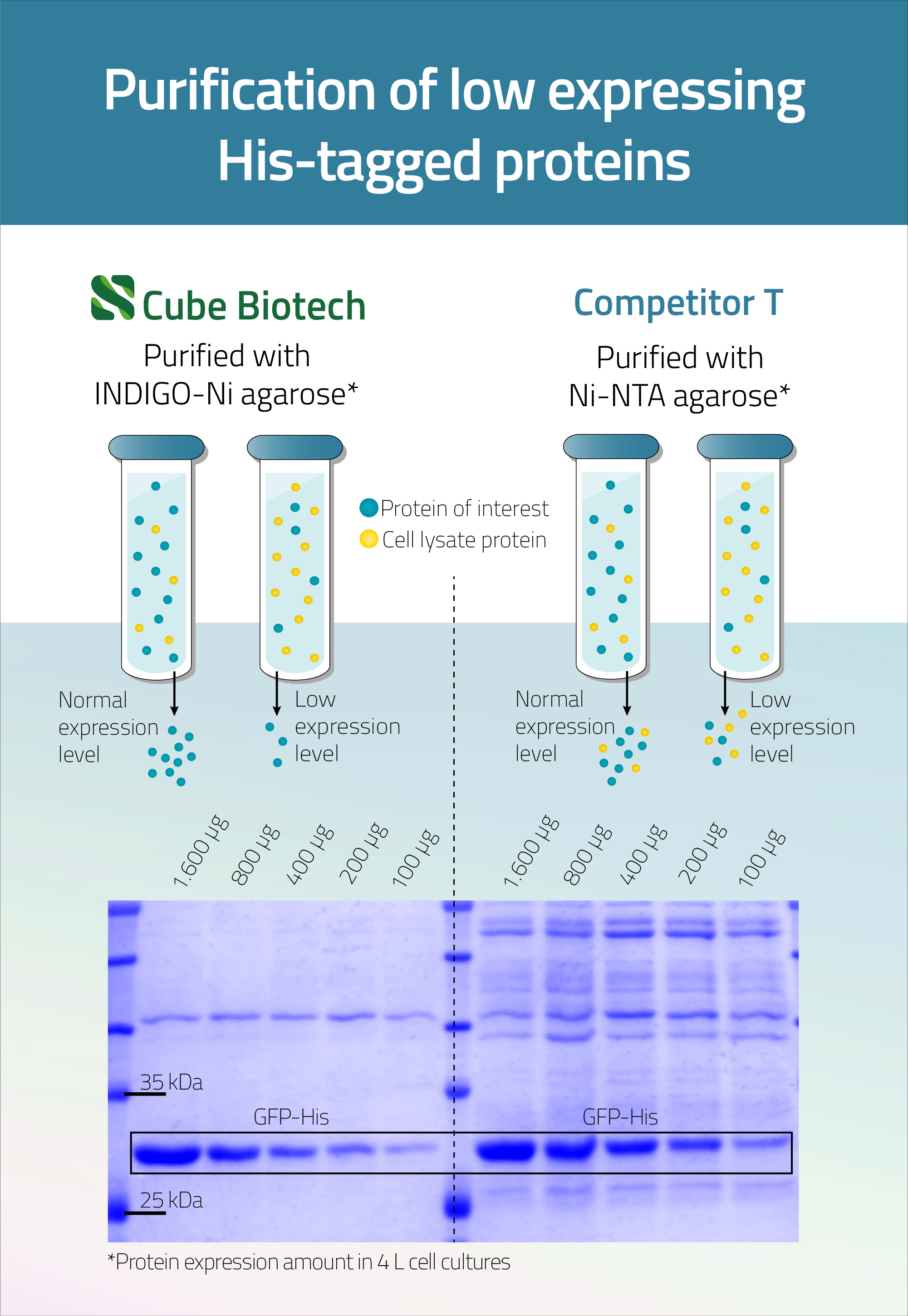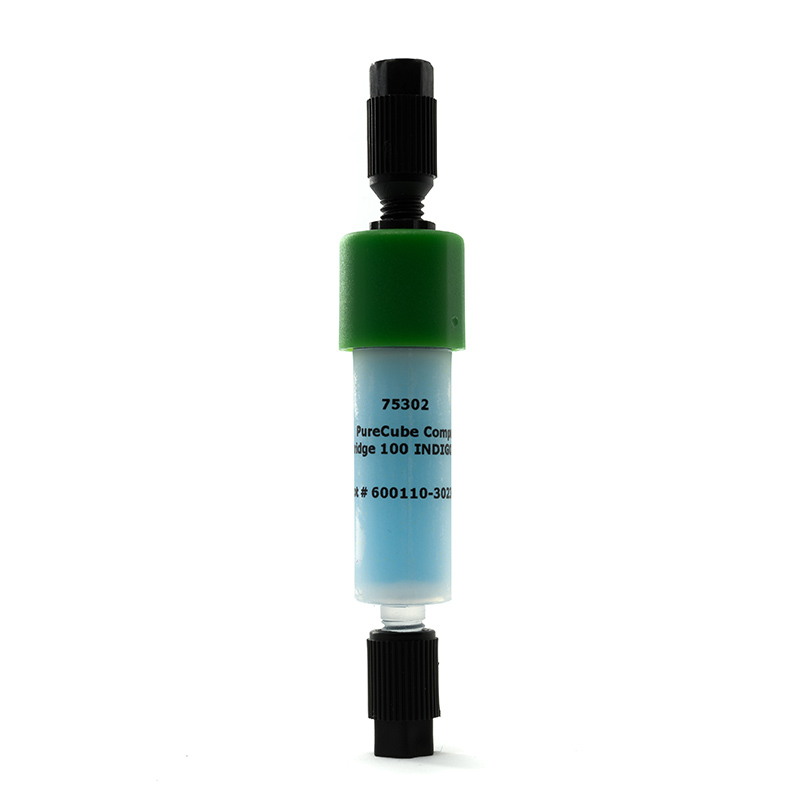PureCube 100 Compact Cartridge Ni-INDIGO
Order number: 75302
Description
The PureCube Ni-INDIGO Column / Cartridge is an IMAC chromatography column prepacked with PureCube 100 INDIGO-Ni Agarose resin beads. You can choose between two sizes, 1 mL bed volume and 5 mL bed volume. The PureCube cartridge/column that is used here is compatible with almost all commonly used FPLC systems like ÄKTA TM. We further recommmend checking out our other Ni-INDIGO products.
Datasheets
| Feature - Purification Beads | |
|---|---|
| Usage | Specific binding and purification of 6x His tagged proteins |
| Specificity | Affinity to His tagged proteins |
| Binding capacity | >100 mg/mL |
| Bead Ligand | Ni-INDIGO |
| Bead size | 100 μm |
| Matrix | 6% highly cross-linked agarose |
| ph Stability | 2-13 |
| Chelator stability | Stable in buffer containing 20 mM DTT and 20 mM EDTA |
| Feature - Column | ||
|---|---|---|
| PureCube Compact Cartridge 1 mL | PureCube Compact Cartridge 5 mL | |
| Bed Volume | 1 mL | 5 mL |
| Max. Flow Rate | 6 mL/min | 6 mL/min |
| Dimensions: diameter X length (mm) | 5 X 35 | 17 X 35 |
| Body material | Polypropylene | Polypropylene |
| Inlet | 10-32 UNF female thread | 10-32 UNF female thread |
| Outlet | 10-32 UNF female thread | 10-32 UNF female thread |
Citations
| Protein | Year | Author |
|---|---|---|
| B7-H6 | 2022 | Viktorie M. |
| NK cell receptor Clr-b | 2022 | Urbanová Z. |
| ClpP peptidase | 2022 | Walker S.D. |
| Human ACE2 | 2022 | Jansen-Olliges L., Chatterjee S., Jia L., Stahl F., Bär C., Stadler M., Surup F., Zeilinger C. |
| NKP30 and mutants | 2023 | Tulpa M. |
| ACE2 | 2023 | Wetzel C., Jansel-Olliges L., Stadles M., Surup F., Zeilinger C., Roth B. |
| His-tagged proteins with TEADs | 2023 | Bum-Erdene K., Zhang M., Ghozayel M.K., Gonzales-Gutierrez G., Meroueh S.O. |
Lab Results
INDIGO's key features
INDIGO was developed to solve two problems when it comes to His-tag protein purifications:
The chelator ligand that is mostly responsible for the tolerances against chemicals, capacity and purity. Therefore the goal was to develop & introduce a ligand that withstands commonly used reagents like EDTA, DTT and phenanthroline to give the user a huge benefit.
INDIGO was developed to solve two problems when it comes to His-tag protein purifications:
- The tolerance to certain cell buffer ingredients
- The comparatively low purity of His-tag purifications in general
The chelator ligand that is mostly responsible for the tolerances against chemicals, capacity and purity. Therefore the goal was to develop & introduce a ligand that withstands commonly used reagents like EDTA, DTT and phenanthroline to give the user a huge benefit.

EDTA and DTT resistance of the INDIGO ligand
Protein purification is not limited to simple organisms like E.coli. Also more complex cells like mammalian cells or insect cell lines can be used to express & purify proteins. These systems come with more complex buffer compositions and some of their ingredients may interfere with traditional IMAC ligands. These include:
EDTA is often used in mammalian cell buffers to inhibit any proteases that would decrease the protein yield. But it also strips the NTA and IDA ligands of their nickel ions, thus making the beads useless.
DTT on the other hand can be used to dissolve protein aggregates in the cell lysate that might hinder the access to the protein's His-tag. By reducing nickel, thus making the beads useless.
Phenanthroline as a protease inhbitor is a strong chelator. And therefore behaves similar to EDTA.
To address all these issues, our R&D Team developed our INDIGO ligand that increases to EDTA, DTT and phenanthroline tolerance of a His-tag purification procedure up to 20 mM each.
Protein purification is not limited to simple organisms like E.coli. Also more complex cells like mammalian cells or insect cell lines can be used to express & purify proteins. These systems come with more complex buffer compositions and some of their ingredients may interfere with traditional IMAC ligands. These include:
EDTA is often used in mammalian cell buffers to inhibit any proteases that would decrease the protein yield. But it also strips the NTA and IDA ligands of their nickel ions, thus making the beads useless.
DTT on the other hand can be used to dissolve protein aggregates in the cell lysate that might hinder the access to the protein's His-tag. By reducing nickel, thus making the beads useless.
Phenanthroline as a protease inhbitor is a strong chelator. And therefore behaves similar to EDTA.
To address all these issues, our R&D Team developed our INDIGO ligand that increases to EDTA, DTT and phenanthroline tolerance of a His-tag purification procedure up to 20 mM each.

INDIGO's protein purity compared to Ni-NTA & reuseability
As previously mentioned, His-tag protein purification assays can fall behind in terms of purity compared to other affinity tags. Good examples for this are antibody-affinity tags like FLAG or Rho1D4.
On the other hand, FLAG and Rho1D4 purifications, result in very low protein amounts (up to 3-4 mg/ml resin at best) and are better suited for proteins with low abundance.
As previously mentioned, His-tag protein purification assays can fall behind in terms of purity compared to other affinity tags. Good examples for this are antibody-affinity tags like FLAG or Rho1D4.
On the other hand, FLAG and Rho1D4 purifications, result in very low protein amounts (up to 3-4 mg/ml resin at best) and are better suited for proteins with low abundance.

His-tag protein purification achieves the highest possible protein yields. In our in-house quality controls for Ni-INDIGO resin we usually get around 100 mg protein per ml resin. The protein used for the quality controls is His-tagged GFP. This Video-Guide shows His-Tag purification using our His-Affinity beads.
Furthermore, INDIGO beads can be reused multiple times as demonstrated in figure 3. In addition to that they can be regenerated following this protocol.

Video
Video Guide - FPLC
FAQ
Can I get the datasheet for the 100 INDIGO-Ni COMPACT cartridge?
What are the reasons for non specific binding?
Some histidine rich proteins can also bind to nickel. But washing with NaOH after elution of your protein of interest removes unspecific bound proteins from your resin.
I want to use high concentration of EDTA and DTT. Is it possible to use Ni-INDIGO from Cube Biotech?
Yes, of course. Infact Ni-INDIGO was developed with the intention to be highly tolerant towards chelators like EDTA and reducing agents like DTT. Both substances are tolerated up to 20mM.
What is the difference of Ni-INDIGO to Ni-NTA?
As the name suggest the ligand that binds to nickel ions to the purification beads is different. INDIGO binds ions like stronger than NTA an IDA. This results in the increased EDTA and DTT tolerance.
Is protein purification with Ni-INDIGO more complicated than e.g. Ni-NTA
No, it is not. Infact, both of our Ni-NTA beads and their corresponding Ni-INDIGO counterpart share the same protocols. This applies to purifications using native and denaturing conditions.
Can Ni-INDIGO beads be stripped like NTA or IDA beads?
No, this is not possible.
Can I resuse Ni-INDIGO beads or can I regenerate them?
Yes, you can reuse the beads! We recommend to use our INDIGO washing & regeneration protocol at least after every 5th use of the beads.
Note that protocols for e.g. Ni-NTA bead regeneration do NOT apply to INDIGO beads.
Note that protocols for e.g. Ni-NTA bead regeneration do NOT apply to INDIGO beads.




